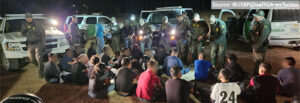U.S. Deportation Practices Elevate Risks at the Border
Nearly two million people have been deported from the United States since 2009. More than 70 percent of these migrants are Mexicans who have been deported to Mexican border cities. Certain U.S. deportation practices are putting migrants at risk of being kidnapped, extorted, and even killed by drug cartels and criminal groups operating along the border.
Eliminating unsafe deportation practices will bring greater order and security to the deportation process.
Deportations to increasingly dangerous Mexican border cities
Between 2009 and 2012, research conducted by WOLA identified a troubling trend: the United States increased deportations to Mexican border cities, at the same time the murder rate in those cities was rapidly rising. And still today, even as indices of violence remain elevated, deportations to these dangerous cities continue at very high rates.
According to Mexico’s National Migration Institute, between 2006 and 2012 deportations to Tamaulipas State increased five-fold, from 25,376 to 122,036 annually. Over the same period reported homicides in Tamaulipas State have more than doubled. Matamoros, the Mexican city bordering Brownsville, Texas, is one of the most turbulent cities in Tamaulipas. Acknowledging the heightened insecurity and upward trends in violence, the State Department has restricted the movement of U.S. government employees in Matamoros to the hours of 6:00 AM to midnight. But deportations to the city have risen dramatically, increasing nearly five times since 2008.
Night Deportations
A recent survey by the University of Arizona found that approximately one in five migrants report being deported between 10:00 PM and 5:00 AM. At this rate, we can conclude that tens of thousands of people have been deported at night. And many more thousands will be left in the middle of the night in the coming year if nighttime deportations continue. Emergency shelters, transportation, financial, and other services are not available overnight in many cities. Nighttime deportations to unfamiliar cities present commonplace challenges, such as finding a place to sleep and figuring out how to communicate with friends and family. These risks are greatly exacerbated when migrants are deported during overnight hours to cities where organized criminal groups routinely operate.
Separation of Families and Lateral Deportations
Concerns about the practice of “lateral repatriation” have been rising as documented cases of families being separated in the process are mounting. The practice moves undocumented male migrants—but not their wives or families— from the sector where they were detained to another location, often hundreds of miles away. This frequently results in the repatriation of Mexican migrants to cities with which they are unfamiliar, and which may lack social services. When a husband and wife are detained while traveling together, and only he is laterally repatriated, his wife will be repatriated alone. This unnecessarily exposes women migrants to high risks of assault and potentially sexual exploitation. In the case of lateral deportation and family separation, the deportees are frequently given no information regarding the whereabouts of their spouses.
Seizures of Belongings
The lack of access to services and safety networks is exacerbated when migrants’ belongings are not returned to them during the deportation process. According to the University of Arizona study, 39 percent of migrants report losing their possessions during the detention and deportation process. Their belongings are taken and not returned; instead, they receive a check for the value of these items. Without important documents such as ID, cash, credit and debit cards, as well as their cell phones, many migrants are left stranded in unfamiliar, often dangerous, border cities without the possibility of accessing funds and communicating with family and friends. They are exposed to harassment and can be detained by local police because they don’t have identification documents.
Lack of Adequate Shelters and Services
NGOs and faith-based groups that provide shelter to recently deported people report that U.S. government agencies are not adequately coordinating with the local NGOs to ensure that the necessary services are available to migrants. NGOs often have crucial information about the schedule and availability of social services, as well as the challenges associated with safeguarding migrants’ lives and wellbeing through the deportation process. For example, in Tijuana, just south of San Diego, California, there are 12 migrant shelters. However, the United States has reduced deportations to the service-rich environment by a full third since 2009. In contrast, only one shelter operates in Matamoros, a city that has seen massive growth in deportations. Better coordination with the NGO and faith-based community, in the form of a clear, transparent, and public process through with NGOs, can provide U.S. authorities with information that could be helpful as they negotiate local arrangements with the Mexican authorities for the repatriation of Mexican nationals. This would be a simple practice that could meaningfully increase the safety and security of deported migrants.
For more information, see WOLA’s video on unsafe deportation practices that put migrants at risk.

